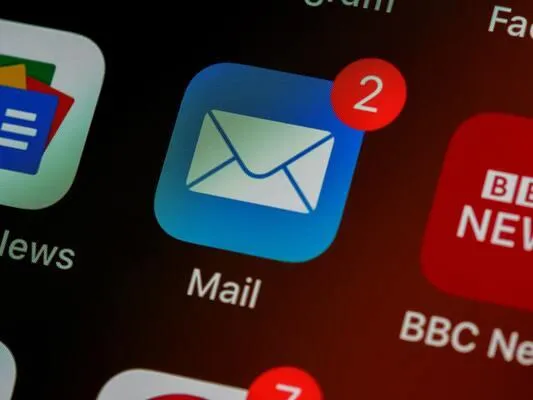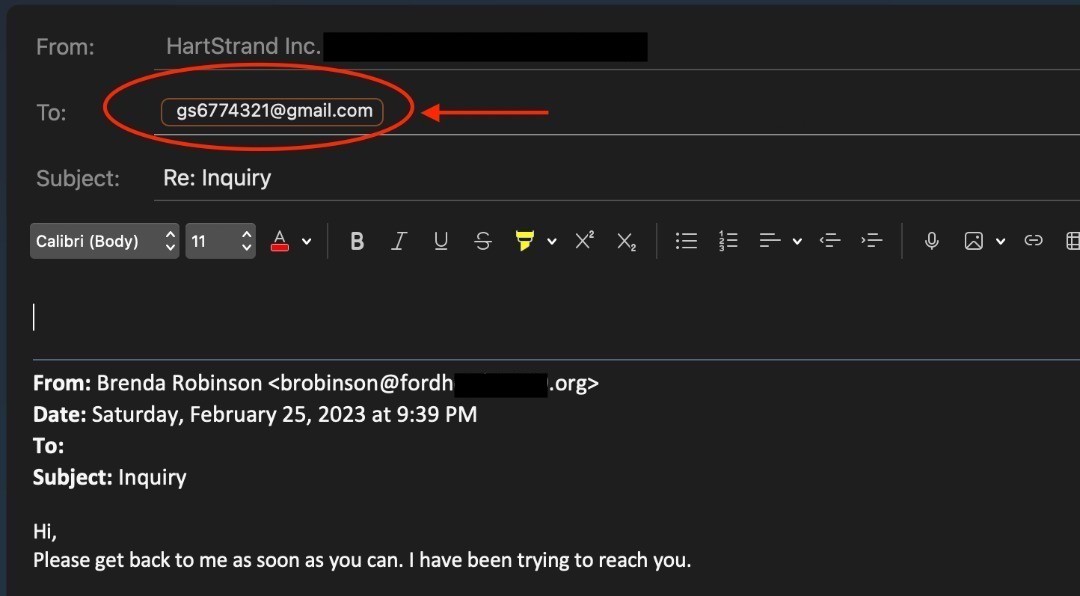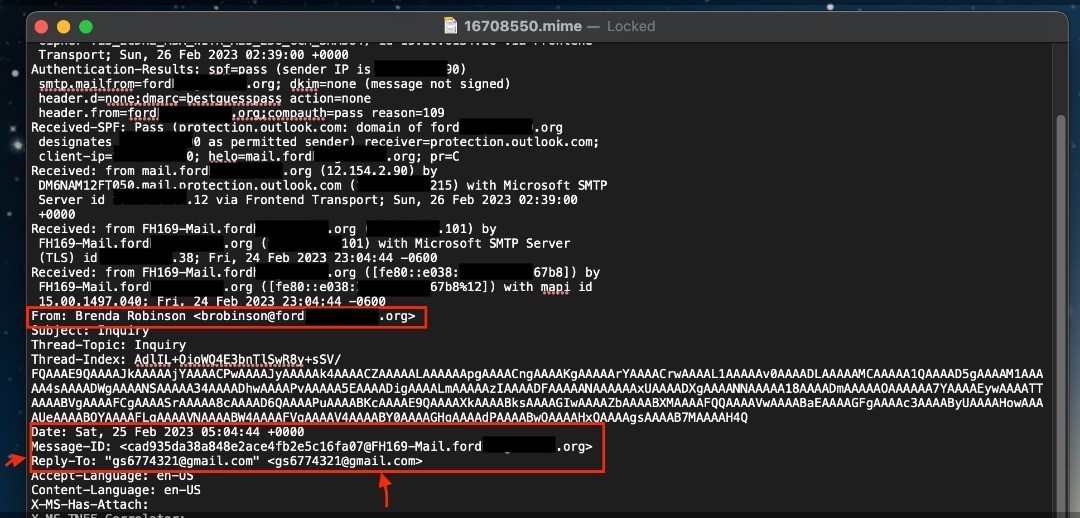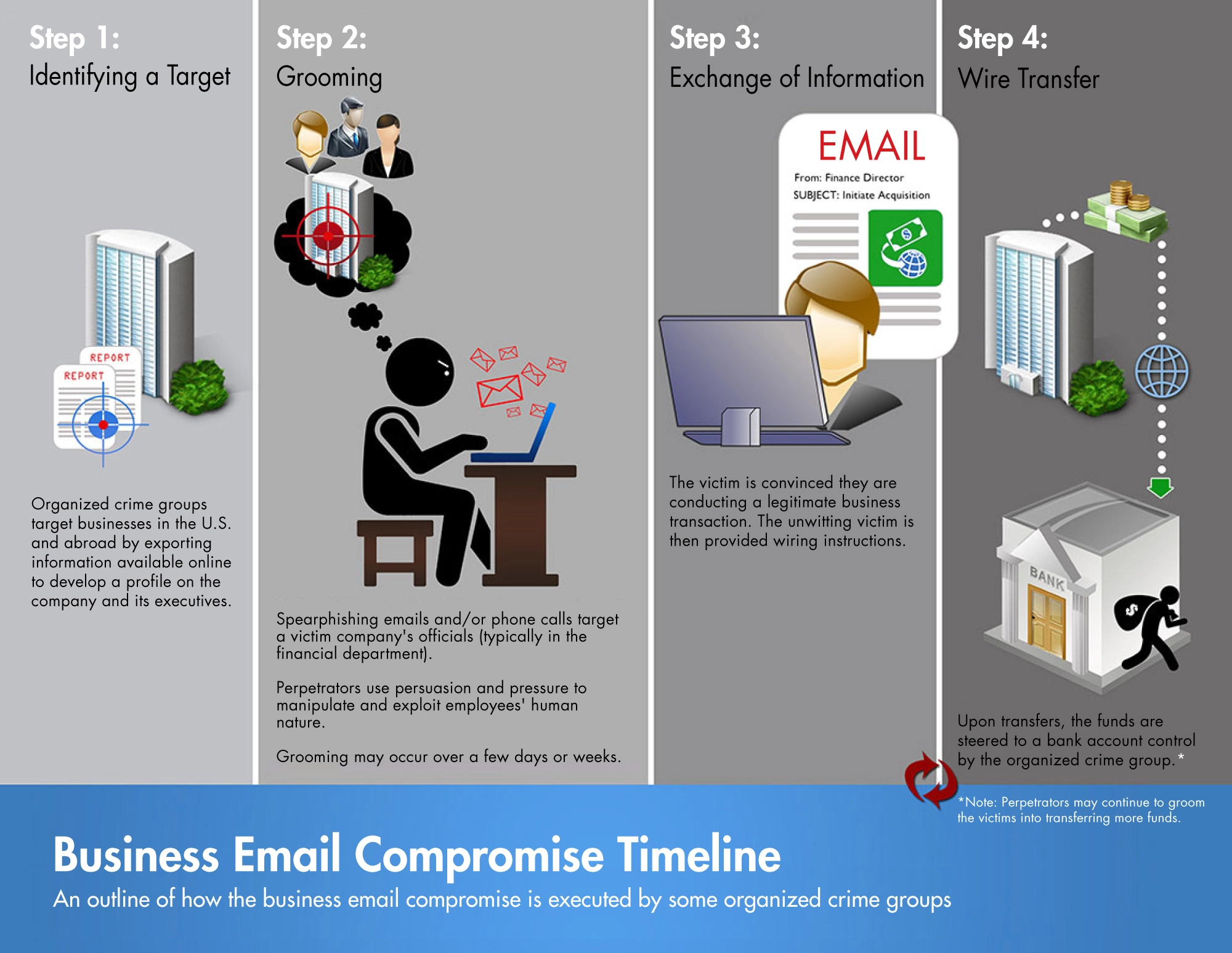Tech Insights & Cyber News
Stay Ahead of the Game
Stay Up-to-Date with the Latest Cyber News and Insights
Stay informed and ahead of the curve with our Cyber Insights page, where you can find thought-provoking blogs and articles on the latest developments in the world of cybersecurity. From new threats to innovative solutions, our expert authors bring you up-to-date information and analysis to help you safeguard your organization in an ever-changing landscape.
Insights & Cyber News

How to Prevent Email Spoofing: Protect Your Business from Cybercriminals
Email spoofing is a common form of cyber attack that involves sending fake emails that appear to be from a legitimate source. These emails are used to trick people into giving away sensitive information or downloading malicious software. Email spoofing is a serious threat to businesses of all sizes, and it is essential to take steps to protect your organization from this type of attack. In this article, we at HartStrand will explain what email spoofing is, why it is dangerous, and provide you with practical steps you can take to prevent it.
Table of Contents
What is Email Spoofing?
Why is Email Spoofing Dangerous?
How do Cybercriminals Carry Out Email Spoofing?
What Are The Common Types of Email Spoofing Attacks?
How to Identify Email Spoofing?
Steps to Prevent Email Spoofing
Implement SPF, DKIM, and DMARC
Use Encryption
Train Your Employees
Implement Multi-factor Authentication
Keep Your Software Up-to-date
Monitor Your Email Traffic
Use Anti-Spam Filters
What to Do if You Suspect Email Spoofing?
Conclusion
FAQs
1. What is Email Spoofing?
Email spoofing is a type of cyber attack where the attacker sends an email that appears to come from a trusted source, such as a legitimate business, bank, or government agency. The attacker alters the email's "From" address so that it looks like it came from a legitimate source. The email may contain a message that tries to trick the recipient into taking a specific action, such as revealing sensitive information or downloading malware.
2. Why is Email Spoofing Dangerous?
Email spoofing can be dangerous because it can be used to steal sensitive information, spread malware, or launch other types of cyber attacks. For example, an attacker may use email spoofing to send a fake email to an employee of a business, tricking them into revealing their login credentials or downloading malware onto their computer. The attacker can then use this information to gain unauthorized access to the business's network or steal sensitive data.
3. How do Cybercriminals Carry Out Email Spoofing?
There are several ways that cybercriminals can carry out email spoofing attacks. One common method is to use a technique called "phishing," where the attacker sends an email that appears to be from a trusted source, such as a bank or government agency. The email may contain a message that tries to trick the recipient into revealing sensitive information, such as login credentials or financial information.
Another method is to use a technique called "domain spoofing," where the attacker alters the "From" address of the email to make it appear as if it came from a legitimate source. The attacker can use a variety of tools and techniques to make the email look convincing, such as using a similar domain name or altering the email's header information.
See an example below where the cybercriminal spoof an organization's email:

The cyber criminal utilizes some social engineering to make it seem as if you've spoken before or they're just "following up on a urgent request". Note: this particular scenario is a "Purchase Order Scam" where the cybercriminal will lead services providers to believe they need to purchase assets but in truth, they get the provider to purchase items on "NET30" terms to then disappear. Thus leaving the provider out of money, reaching out to the real organization who never made the purchase. You can find more details on how this works and how to report it here at the FBIs reporting site.

Notice that the "reply-to" is different from the Original Sender and points to a gmail account. Not uncommon to see outlook, aol, yahoo, etc.

You can dig even further by inspecting the email headers. Recommend always contacting the agency and notifying them if you weren't expecting an email or to validate. DO NOT use the contact information in the email as the cybercriminals are usually placing a number where they can further make you believe it is legitimate.
4. What Are The Common Types of Email Spoofing Attacks?
There are several common types of email spoofing attacks, including:
Phishing attacks
Business email compromise (BEC) attacks
CEO fraud
Domain spoofing
5. How to Identify Email Spoofing?

Identifying email spoofing can be challenging, as the emails can look very convincing. However, there are several signs that you can look out for, including:
Suspicious email addresses or domain names: Check the sender's email address and domain name. If it looks unusual or suspicious, it may be a spoofed email.
Poor grammar or spelling errors in the email: Spoofed emails may contain poor grammar, spelling errors, or awkward phrasing that a legitimate sender would not use.
Urgent or threatening language in the email: Spoofed emails may try to create a sense of urgency or threaten dire consequences to pressure the recipient to act quickly.
Unusual requests or demands: Spoofed emails may contain unusual requests or demands, such as asking the recipient to provide sensitive information or transfer funds to a specific account.
If you are unsure whether an email is legitimate or not, it's always better to err on the side of caution and contact the sender directly to confirm the email's authenticity.
6. Steps to Prevent Email Spoofing
Now that you understand what email spoofing is and why it's dangerous, it's time to take steps to prevent it. Here are some practical steps you can take to protect your business from email spoofing attacks:
Step 1. Implement SPF, DKIM, and DMARC
SPF, DKIM, and DMARC are three email authentication protocols that work together to help prevent email spoofing. SPF (Sender Policy Framework) is used to verify that the email is coming from an authorized server. DKIM (DomainKeys Identified Mail) uses a digital signature to verify that the email has not been tampered with. DMARC (Domain-based Message Authentication, Reporting & Conformance) combines both SPF and DKIM to prevent unauthorized emails from being delivered. There are services you can utilize to implement or assist in implementation like EasyDMARC.
Step 2. Use Encryption
Using encryption to protect your emails can prevent cybercriminals from intercepting and reading your messages. Encryption works by scrambling the contents of your email so that it can only be read by the intended recipient.
Step 3. Train Your Employees
One of the most effective ways to prevent email spoofing attacks is to train your employees to be aware of the risks. Educate them on how to identify suspicious emails and what to do if they receive one. Make sure they know not to click on links or download attachments from unknown sources.
Step 4. Implement Multi-factor Authentication
Multi-factor authentication adds an extra layer of security to your email accounts. It requires the user to provide two or more forms of authentication, such as a password and a fingerprint or a code sent to their phone, before accessing their account.
Step 5. Keep Your Software Up-to-date
Keeping your software up-to-date is essential to protect against email spoofing attacks. Make sure that your email software, operating system, and other applications are all running the latest version with the most up-to-date security patches.
Step 6. Monitor Your Email Traffic
Regularly monitoring your email traffic can help you identify any suspicious activity. Use email security tools to monitor your inbound and outbound emails and look for any unusual activity or patterns.
Step 7. Use Anti-Spam Filters
Anti-spam filters can help prevent unwanted emails from reaching your inbox. These filters can identify and block suspicious emails before they reach your email server.
7. What to Do if You Suspect Email Spoofing?
If you suspect that your business has been the victim of email spoofing, there are several steps you can take:
Contact your IT department or email service provider immediately.
Change your passwords for all accounts that may have been compromised.
Review your email logs to identify any suspicious activity.
Notify your customers or business partners if their information may have been compromised.
8. Conclusion
Email spoofing is a serious threat to businesses of all sizes. By implementing the steps outlined in this article, you can help protect your business from this type of cyber attack. Remember to regularly monitor your email traffic, use anti-spam filters, and train your employees to be aware of the risks. By taking these steps, you can help prevent email spoofing attacks and keep your business safe.
9. FAQs
What is the difference between email spoofing and phishing?
Can email spoofing be prevented?
What is SPF, DKIM, and DMARC?
How do I know if I've been the victim of email spoofing?
What should I do if I receive a suspicious email?
FAQ Answers
Email spoofing and phishing are related, but they are not the same thing. Email spoofing involves sending an email that appears to be from a legitimate source, while phishing involves sending an email with the intention of tricking the recipient into revealing sensitive information or downloading malware.
Yes, email spoofing can be prevented. By implementing email authentication protocols like SPF, DKIM, and DMARC, using encryption, and training employees to be aware of the risks, businesses can protect themselves from email spoofing attacks.
SPF, DKIM, and DMARC are email authentication protocols that work together to prevent email spoofing. SPF verifies that the email is coming from an authorized server, DKIM uses a digital signature to verify that the email has not been tampered with, and DMARC combines both to prevent unauthorized emails from being delivered.
If you suspect that you've been the victim of email spoofing, there are several signs to look out for, including suspicious email addresses or domain names, poor grammar or spelling errors in the email, urgent or threatening language, and unusual requests or demands. You can also review your email logs to identify any suspicious activity.
If you receive a suspicious email, do not click on any links or download any attachments. Instead, delete the email or forward it to your IT department or email service provider for review. It's also a good idea to educate yourself and your employees on how to identify and avoid phishing emails.
In conclusion, email spoofing is a serious threat to businesses, but there are practical steps you can take to protect yourself from this type of cyber attack. By implementing email authentication protocols, using encryption, and training your employees to be aware of the risks, you can help prevent email spoofing attacks and keep your business safe. Remember to monitor your email traffic regularly, use anti-spam filters, and stay up-to-date with the latest security patches to stay ahead of cybercriminals.
Here are some websites that provide information and resources to help prevent email spoofing:
The National Cyber Security Centre (NCSC) - Email Spoofing: https://www.ncsc.gov.uk/guidance/email-spoofing
The Federal Trade Commission (FTC) - How to Recognize and Avoid Phishing Scams: https://www.consumer.ftc.gov/articles/how-recognize-and-avoid-phishing-scams
The Cybersecurity and Infrastructure Security Agency (CISA) - Email Phishing: https://www.cisa.gov/email-phishing
Microsoft - Email Spoofing: https://docs.microsoft.com/en-us/microsoft-365/security/office-365-security/email-spoofing
The Anti-Phishing Working Group (APWG): https://apwg.org/
EasyDMARC - Check Your Domain: https://easydmarc.com/
We are available to assist
24 x 7 x 365.
Call Us at (833) 447-0672
Industries
Banking & Financial Services
Communications
Consumer Products
Utilities
Healthcare
Information Services
Insurance
Manufacturing
Oil & Gas
Media & Entertainment
Retail
Technology & Engineering
Transportation & Logistics
Travel & Hospitality
Engineering
Expertise
Consulting
Solutions On Demand
Privacy Policy | Cookie Policy | Terms and Conditions | UEID: KW1FKQ199HY1 | CAGE: 9C6V1
Copyright (c) 2025 HartStrand ® All Rights Reserved.


